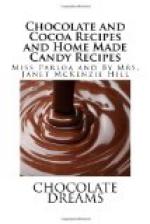“I could produce several instances,” he says, “in favor of this excellent nourishment; but I shall content myself with two only, equally certain and decisive, in proof of its goodness. The first is an experiment of chocolate’s being taken for the only nourishment—made by a surgeon’s wife of Martinico. She had lost, by a very deplorable accident, her lower jaw, which reduced her to such a condition that she did not know how to subsist. She was not capable of taking anything solid, and not rich enough to live upon jellies and nourishing broths. In this strait she determined to take three dishes of chocolate, prepared after the manner of the country, one in the morning, one at noon, and one at night. There chocolate is nothing else but cocoa kernels dissolved in hot water, with sugar, and seasoned with a bit of cinnamon. This new way of life succeeded so well that she has lived a long while since, more lively and robust than before this accident.
“I had the second relation from a gentleman of Martinico, and one of my friends not capable of a falsity. He assured me that in his neighborhood an infant of four months old unfortunately lost his nurse, and its parents not being able to put it to another, resolved, through necessity, to feed it with chocolate. The success was very happy, for the infant came on to a miracle, and was neither less healthy nor less vigorous than those who are brought up by the best nurses.
“Before chocolate was known in Europe, good old wine was called the milk of old men; but this title is now applied with greater reason to chocolate, since its use has become so common that it has been perceived that chocolate is, with respect to them, what milk is to infants. In reality, if one examines the nature of chocolate a little, with respect to the constitution of aged persons, it seems as though the one was made on purpose to remedy the defects of the other, and that it is truly the panacea of old age.”
The three associated beverages, cocoa, tea, and coffee are known to the French as aromatic drinks. Each of these has its characteristic aroma. The fragrance and flavor are so marked that they cannot be imitated by any artificial products, although numerous attempts have been made in regard to all three. Hence the detection of adulteration is not a difficult matter. Designing persons, aware of the extreme difficulty of imitating these substances, have undertaken to employ lower grades, and, by manipulation, copy, as far as may be, the higher sorts. Every one knows how readily tea, and coffee, for that matter, will take up odors and flavors from substances placed near them. This is abundantly exemplified in the country grocery or general store, where the teas and coffees share in the pervasive fragrance of the cheese and kerosene. But perhaps it is not so widely understood that some of these very teas and coffees had been artificially flavored or corrected before they reached their destination in this country.




